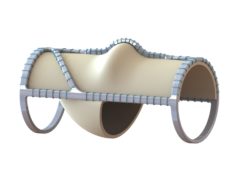
A retrospective analysis of patients diagnosed with lower extremity lymphoedema, and treated in a cancer-affiliated physical therapy department, has found that chronic venous insufficiency (or phlebolymphoedema) is the “predominant cause of lower extremity lymphoedema”. Published online in the Journal of Vascular Surgery: Venous and Lymphatic Disorders, it was also revealed by investigators that one in four patients studied had more than one cause of lymphoedema.
“Although malignant disease is ubiquitously documented as the dominant cause of lower extremity lymphoedema, our study challenges this doctrine by finding chronic venous insufficiency the prevailing cause,” write first author Steven M Dean (Wexner Medical Center, The Ohio State University, Columbus, USA) and colleagues.
According to the authors, “lower extremity lymphoedema is frequently encountered in the vascular clinic”. They explain that cancer is understood to be the most common cause of this condition in Western countries, with chronic venous sufficiency “overlooked” as a possible factor as to why lower extremity lymphoedema develops. “Moreover, lymphoedema is typically ascribed to a single cause, yet multiple causes can coexist,” Dean et al add.
Citing the “dearth of definitive studies” comparing the frequency and importance of clinical characteristics of the most frequent causes, the investigators state: “The purpose of this study was to retrospectively document the prevalence and manifestations of the four most commonly encountered causes of lower extremity lymphoedema in 440 patients who presented to an oncology-affiliated physical therapy lymphoedema centre”.
In order to investigate the demographic and clinical characteristics of eligible patients, a three-year retrospective chart review was conducted from January 2012 to December 2015, including patients with lower extremity lymphoedema who underwent complex decongestive lymphatic physiotherapy (n=524). A proportion of patients (n=84) were excluded from the final analysis, note Dean et al, due to an infrequent or rare cause of lymphoedema, inadequate data to definitively substantiate the principal cause, and the presence of secondary causes or associated clinical variables.
“After exclusion, 440 eligible patients were initially divided into […] four principal diagnostic categories, reflecting the predominant cause of leg swelling,” the authors detail. These categories included chronic venous insufficiency causing lymphoedema, cancer-related lymphoedema, primary lymphoedema, and lipoedema with lymphoedema. Dean and colleagues continue: “Patients within each of the four principal diagnoses were analysed by demographic and baseline characteristics including age, sex, ethnicity, weight, body mass index (BMI), and anatomic distribution.”
Summarising the results, the investigators underline that chronic venous insufficiency was the most common cause of the condition, as demonstrated in 41.8% of the cohort. Cancer-related lymphoedema followed (33.9%), with primary lymphoedema (12.5%) third and lipoedema with secondary lymphoedema (11.8%) fourth.
Other findings of the analysis, as described by Dean et al, showed that “the collective cohort was more likely to be female (71.1%; p<0.0001), to be white (78.9%; p<0.0001), to demonstrate bilateral distribution (74.5%; p<0.0001), and to have involvement of the left leg (bilateral, 69.1% [p<0.0001]; unilateral, 58.9% [p=0.0588])”. Morbid obesity was also considered to be “nearly universal” (mean weight and body mass index, 115.8 kg and 40.2 kg/m2, respectively) among the cohort studied.
Dean et al conclude: “Although lymphoedema is typically ascribed to a single cause, we identified heterogeneous causation in one in four patients. Chronic venous insufficiency was the entity most likely to complicate pre-existing lymphoedema and was especially prevalent in cases of lipoedema and, unexpectedly, primary lymphoedema. Morbid obesity was pervasive and correlated with a higher lymphoedema stage, and likely the predisposition to bilateral limb involvement.
“Other notable findings included the predilection for left leg involvement, female sex proclivity, and confirmation of cellulitis susceptibility, which affected half of the chronic venous insufficiency and primary lymphoedema subsets. Total knee arthroplasty was the most common cause of non-cancer surgery-mediated worsening of pre-existing lymphoedema. An unexpected finding was the higher proportion of black patients in the primary lymphoedema cohort.”










Questions:
Was data collected from multiple sites/cities/locations? Is the cohort reflective of the global population?
Evidence already tells us that untreated CVI leads to LE. Was this included in the analysis?